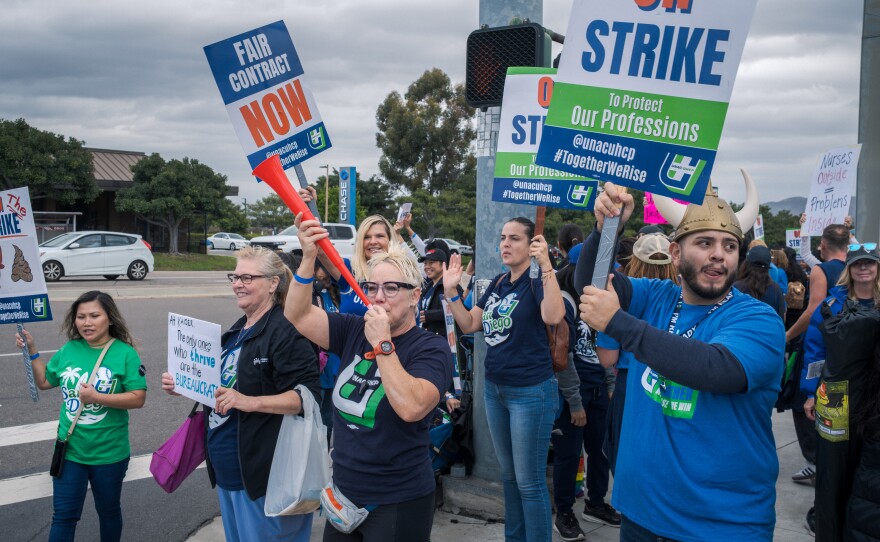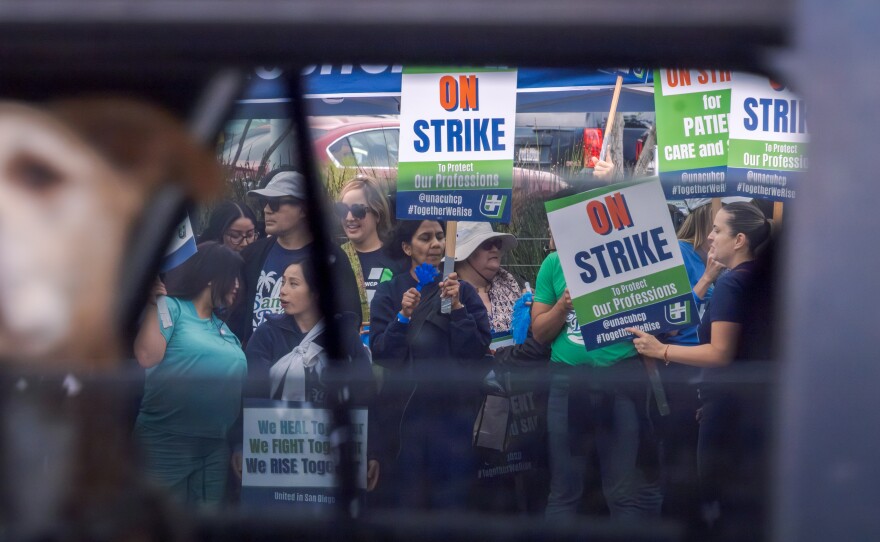Thousands of health care workers represented by the United Nurses Associations of California/Union of Health Care Professionals walked off the job Tuesday morning at Kaiser Permanente facilities across San Diego County. Nurses, pharmacists and other frontline staff are demanding safe staffing, fair pay, and improved benefits.
Outside Kaiser Permanente’s San Diego Medical Center, health care workers lined the sidewalks, bracing against strong winds, signs in hand.
“It doesn't matter whether we're pharmacists, nurses, physical therapists, or dietitians. We all have one goal. And our goal is to take care of our patients and to do it safely," said Neda Moghaddam, a Kaiser pharmacist.

She said having enough staff and proper training is critical.
“We ask for training, we ask for bodies,” she said. “Pizza parties don't do it. That's not what we want. We need the support to be able to make sure our patients are safe.”
Moghaddam said now is the right time to strike because four years ago, burnout from COVID-19 left staff with little energy to push for a fair contract.
An estimated 2,000 Kaiser workers are on strike in San Diego County, part of a larger, 31,000-member walkout across California, Hawaii and Oregon.
Union leaders said the strike isn’t just about pay or staffing. They’re also pushing for better retirement security and benefits. They said Kaiser’s perks do not fully make up for years of stagnant wages.
Nurse Nikki Avey, who has worked in labor and delivery for 20 years, said she works three jobs to keep up with rising costs.
“You'll find that a lot of nurses, if you ask them, they're always having some sort of side job. One job is not enough,” Avey said.

Avey said the strike isn't just about wages, it’s about patient safety. She said patients are sicker and care is more complex, but staffing levels haven’t kept pace with the growing needs.
"They're not just at low-risk deliveries or low-risk pregnancies anymore. They need to have that quality care, more attention on them, and it's just really difficult because I am so stretched thin."
The union said years of short-staffing and burnout are driving health professionals to leave the bedside, putting new pressure on those who stay.
"I'm delivering babies every day. If an emergency happens, and I don't have the right staff to help me get through that, then it is detrimental to our patients, and our patients' lives are at risk," Avey said.
Negotiations have been ongoing since May. Union leaders said they’ve asked for higher wages to keep up with the rising cost of living, while Kaiser said its latest proposal balances fair pay with keeping costs manageable for patients.
The hospital said it’s bringing in temporary licensed staff to maintain care and calls the strike “unnecessary and disruptive.”
But for Moghaddam, standing on the picket line with her colleagues rallied alongside her, she said it’s about the one goal they all share.
"Taking care of the people that really need to be taken care of. And those are the patients that walk in every day, in every hospital, every clinic, every O.R. room."
The strike is scheduled to run through Sunday. The union and Kaiser said negotiations are ongoing.






